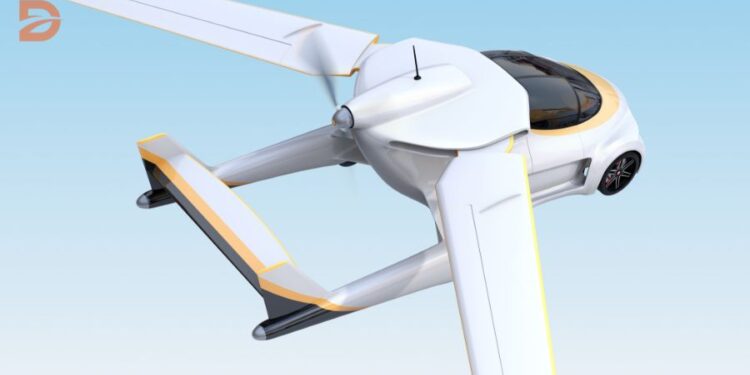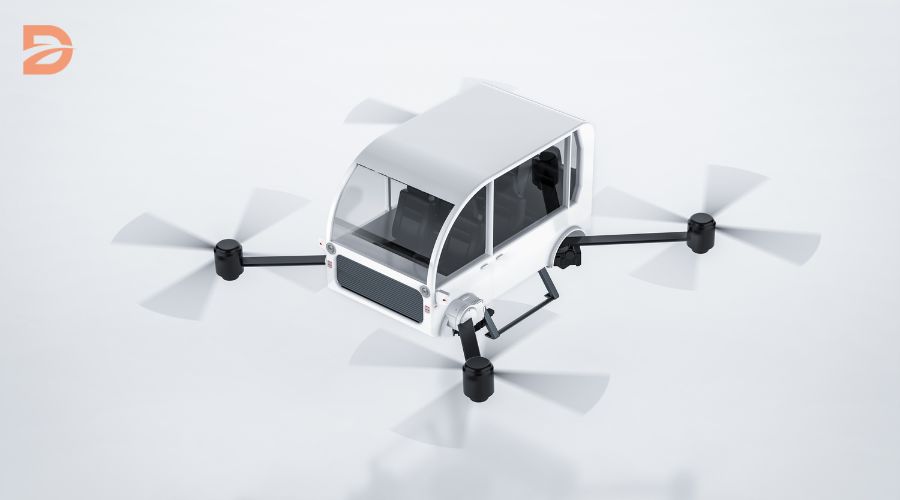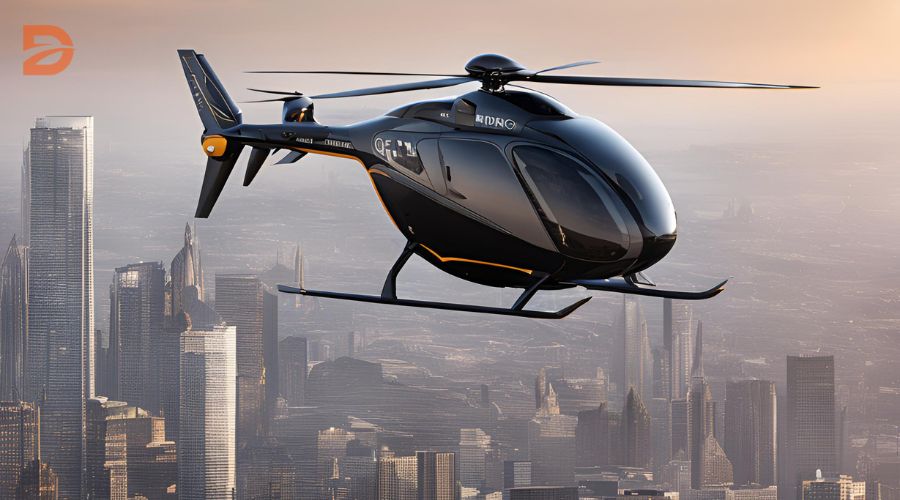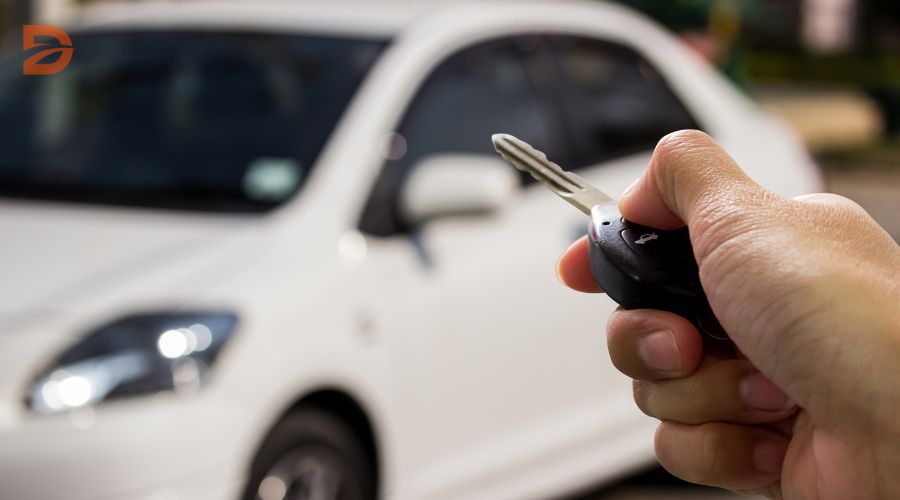By 2030, customers could have access to self-driving, electric air taxis that travel between neighborhood “vertiports,” revolutionizing urban transportation. This unexpected statistic highlights the rapid advancements in the field of advanced air mobility, a term that encompasses everything from flying-car-ish contraptions to traditional airplanes, with a focus on electric vertical takeoff and landing (eVTOL) vehicles.
The “flying car” concept, once the stuff of science fiction, has gained significant traction in recent years, with more than four hundred startups now operating in the advanced air mobility industry. From single-seat playthings to autonomous passenger drones, these personal aerial vehicles are poised to transform the way we move around cities and suburban areas.
Key Takeaways:
- The advanced air mobility industry is rapidly evolving, with over 400 startups working on various eVTOL and flying car technologies.
- By 2030, self-driving, electric air taxis could be a reality, with the potential to transport passengers between “vertiports” in urban areas.
- The 2028 Summer Olympics in Los Angeles may feature the use of eVTOLs to transport athletes, signaling the growing acceptance of these personal aerial vehicles.
- Passenger urban air mobility (pUAM) is projected to increase from 10,000 electric aircraft in 2016 to 160,000 in Europe by 2020, showcasing the rapid growth in this sector.
- The global market size for personal aerial vehicles is estimated to reach tens of billions of dollars by the early 2030s, with the potential for rapid scaling if certain conditions are met.
The Rise of Advanced Air Mobility
The world of aviation is undergoing a transformative shift, as the industry witnesses a rapid surge in the development of advanced air mobility (AAM) technologies. More than 400 startups are currently working on various flying vehicle concepts, from single-seat “eVTOLs” (electric vertical takeoff and landing vehicles) like the Jetson One to autonomous passenger drones like EHang’s Ghost Intelligent Aerial Robot.
This burgeoning ecosystem is driven by the promise of air taxis that can transport passengers between neighborhood “vertiports,” potentially becoming a reality within the next few years. NASA’s Advanced Air Mobility project aims to help develop these electric air taxis and drones, to integrate them into the national airspace by 2030.
Startups Leading the Way
Among the pioneers in this space are companies like Jetson and EHang. Jetson, a Swedish startup, has created the Jetson One, a single-seat eVTOL that offers a glimpse into the future of personal aerial vehicles. Meanwhile, EHang, a Chinese company, has developed the Ghost Intelligent Aerial Robot, an autonomous passenger drone that showcases the potential of eVTOL technology.
These innovative startups are paving the way for a new era of air transportation, addressing the challenges of autonomous flight capabilities and pilot training. As the industry continues to evolve, the integration of eVTOL vehicles and air taxis into the urban landscape promises to redefine the way we move around our cities.
| Company | Vehicle | Key Features |
|---|---|---|
| Jetson | Jetson One | – Single-seat eVTOL – Lightweight and portable – Autonomy and pilot assistance |
| EHang | Ghost Intelligent Aerial Robot | – Autonomous passenger drone – Vertical takeoff and landing – Urban air mobility solution |
Pivotal’s BlackFly: A Pioneer in Personal Aerial Vehicles
In the rapidly evolving world of advanced air mobility, one company is leading the charge in the development of personal aerial vehicles (PAVs) – Pivotal, formerly known as Opener. The company’s flagship product, the BlackFly, has been making waves in the industry as one of the first successful manned eVTOL (electric vertical take-off and landing) flights.
The BlackFly’s origins can be traced back to Canadian inventor Marcus Leng, who developed the initial prototype. Pivotal, recognizing the potential of this innovative technology, has since worked tirelessly to commercialize the vehicle and bring it to the market. The company’s mission is to revolutionize the way people move, offering a safe and accessible alternative to traditional transportation methods.
At the heart of Pivotal’s approach is a strong emphasis on safety. The BlackFly is classified as an “ultralight” aircraft by the Federal Aviation Administration (FAA), which allows it to be operated without the need for a pilot’s license. However, Pivotal takes safety even further, requiring prospective customers to undergo an extensive flight training program to ensure they are equipped to handle the vehicle safely.
| Key Specifications | Value |
|---|---|
| Weight | 348 pounds |
| Propulsion | Eight electric rotors |
| Speed | 62 mph |
| Range | 25 miles |
| Payload | 250 pounds |
The BlackFly’s impressive capabilities, coupled with Pivotal’s unwavering commitment to safety, have made it a pioneer in the PAV market. As the company continues to refine and expand its offerings, the future of personal aerial transportation is poised to take flight, transforming the way we experience the world around us.
Flying Cars: Not Just Science Fiction Anymore
The concept of flying cars is no longer confined to the realm of science fiction. With the rapid advancements in electric propulsion, battery technology, and autonomous systems, a diverse range of flying vehicle categories are emerging, each with its unique capabilities and applications.
One category includes cars that can both drive on roads and take to the skies, such as the Alef Aeronautics Model A. These “flying cars” are designed to provide the convenience of ground transportation combined with the freedom of personal aerial mobility. In contrast, dedicated electric vertical take-off and landing (eVTOL) aircraft, like the Lilium Jet, are not meant for ground transportation but rather offer a new mode of urban air mobility.
The rapid growth of the eVTOL sector is evident, with industry experts predicting it to reach a worth of $1.5 trillion by 2040. However, the categorization and regulation of these new flying vehicle categories pose significant challenges. Regulatory bodies, such as the Federal Aviation Administration (FAA), are working to establish guidelines and safety standards to ensure the safe integration of these innovative technologies into the existing transportation ecosystem.
While the dream of flying cars is no longer confined to science fiction, significant technical and regulatory obstacles remain before they can be widely adopted. Nonetheless, the continued advancements in this field promise a future where personal aerial transportation may become a commonplace reality, transforming the way we commute and experience urban mobility.
Urban Air Mobility: A New Era of Transportation
The future of urban transportation is taking to the skies. Urban air mobility, a concept that envisions the integration of electric vertical take-off and landing (eVTOL) aircraft and air taxis into the transportation infrastructure of cities, is poised to revolutionize how we move around metropolitan areas.
One exciting example is Joby’s planned air taxi service in Manhattan, which aims to shuttle passengers from the city to JFK Airport in just 7 minutes – a journey that can currently take hours by road. This rapid aerial transit has the potential to significantly reduce congestion, improve sustainability, and slash travel times for urban commuters.
Experts predict that the urban air mobility market could see close to 100,000 passenger drones in service worldwide by 2050, with over 100 cities implementing drone services for passenger transport. The vision of a “system of cheap, sustainable aerial transit” with “ribbons of humming vehicles interlaced overhead” is a transformative shift in urban transportation that promises to reshape the way we live and work in cities.
| Year | Passenger Drones in Operation |
|---|---|
| 2020 | 98 |
| 2025 | 75 |
| 2030 | 53 |
| 2035 | 28 |
| 2040 | 12 |
| 2045 | 3 |
| 2050 | 0 |
The development of urban air mobility is not without its challenges, however. Battery technology, regulatory hurdles, and the need for close collaboration between stakeholders must be addressed to realize the full potential of this transformative mode of transportation. But with the rapid advancements in electric propulsion, autonomous flight, and the collective efforts of industry and government, the future of urban aerial transit is poised to take flight.
Flying Cars, Urban Air Mobility: Regulatory Challenges
As the excitement around flying cars and urban air mobility (UAM) continues to grow, the industry faces a critical hurdle: navigating the complex regulatory landscape. The Federal Aviation Administration (FAA) has adopted a “crawl-walk-run” approach to regulating these emerging personal aerial vehicles, requiring them to initially operate within the existing framework of heliports and with a human pilot at the controls.
According to the FAA, this gradual approach aims to ensure the safe integration of these new technologies into the national airspace. However, consumer advocates like Charles Leocha warn that the agency is likely at least a decade away from fully approving personal aerial vehicles for widespread use, as the regulatory process moves at a glacial pace.
FAA’s Approach to Regulating Personal Aerial Vehicles
The FAA’s regulations for personal aerial vehicles, also known as electric Vertical Take-Off and Landing (eVTOL) aircraft, are still evolving. Currently, these vehicles must adhere to the same rules and requirements as traditional helicopters, including the use of existing heliports and the presence of a licensed human pilot.
- Pilot requirements: Operators of personal aerial vehicles must hold a valid pilot’s license, just like helicopter pilots.
- Heliport usage: eVTOL aircraft are limited to operating from designated heliports, as the FAA continues to assess the feasibility of creating new infrastructure for these vehicles.
- Regulatory timelines: Experts are skeptical of the UK government’s plans to enable eVTOL operations within four years, given the slow pace of regulatory approvals in the United States.
The regulatory challenges extend beyond the FAA’s jurisdiction, as companies also grapple with local zoning laws, noise pollution concerns, and the need for a robust supporting infrastructure, such as vertiports and charging stations.
The Future of Personal Aerial Transportation
The future of transportation is taking to the skies as flying cars and urban air mobility solutions emerge as viable options for personal and commercial use. This technological revolution has the potential to dramatically disrupt the traditional air travel industry, offering consumers a new level of convenience and flexibility.
One of the key advancements driving this shift is the development of lightweight, powerful electric propulsion systems. For instance, the e-motor for the Lilium eVTOL jet weighs less than 10 pounds (approximately 4 kilograms), showcasing the significant progress in reducing the weight and size of these critical components. Additionally, innovations in fly-by-wire systems and avionics, such as Honeywell’s Anthem, are making these aerial vehicles more accessible and adaptable to a wider range of users.
The future of personal aerial transportation holds immense promise, with the potential to transform how we travel for both short-haul commutes and long-distance vacation trips. Flying cars could enable faster suburban-to-urban commutes, reducing the time spent in traffic and providing a more efficient alternative to traditional ground transportation. Furthermore, these personal aerial vehicles could potentially compete with commercial aviation for certain routes, disrupting the established air travel industry and offering consumers a more seamless and enjoyable travel experience.
| Technological Advancements | Potential Benefits |
|---|---|
|
|
As the future of personal aerial transportation continues to unfold, we can expect to see a profound impact on the way we think about travel, both for everyday commutes and long-distance vacations. The flying car revolution is poised to reshape the transportation landscape, offering consumers a new level of freedom and efficiency.
Conclusion
As the article has explored, the future of transportation is poised to undergo a revolutionary transformation with the rise of flying cars and urban air mobility. These innovative technologies, spearheaded by visionary startups and supported by government initiatives, hold immense promise to disrupt the way we navigate urban landscapes and experience personal aerial transportation.
While significant technical and regulatory hurdles remain, the growing excitement and momentum surrounding flying cars and urban air mobility is palpable. Estimates suggest the autonomous urban aircraft market could be worth as much as $1.5 trillion by 2040, underscoring the vast potential for these technologies to reshape the future of travel.
From Germany-based Volocopter’s licensed electric air taxis to Japan’s SkyDrive and its all-electric flying cars, the industry is rapidly evolving. Companies like Lilium, Wisk, Joby Aviation, and Bell are leading the charge, leveraging advancements in electric propulsion and battery power to develop innovative Vertical Take-Off and Landing (VTOL) designs. As these cutting-edge solutions continue to take flight, the prospect of a future where flying cars become a mainstream mode of transportation is no longer a mere science fiction fantasy.
FAQ
What is the current state of the “flying car” industry?
The “flying car” or “advanced air mobility” industry is rapidly growing, with over 400 startups working on various aerial vehicle concepts, ranging from single-seat eVTOLs (electric vertical takeoff and landing vehicles) to autonomous passenger drones. Several companies, such as Pivotal with their BlackFly prototype, are making strides in developing and commercializing personal aerial vehicles.
What are the main challenges facing the flying car and urban air mobility industries?
The main challenges include overcoming technical hurdles, such as autonomous flight capabilities and pilot training, as well as navigating the regulatory landscape. Gaining approval from aviation authorities like the FAA for widespread use of these new vehicles is a significant obstacle, with experts estimating it may take at least a decade before personal aerial vehicles are fully approved for consumer use.
How is Pivotal approaching the development and commercialization of their BlackFly eVTOL?
Pivotal, the company behind the BlackFly, has taken a safety-focused approach to the development and commercialization of their eVTOL prototype. This includes an extensive flight training program for prospective customers and ensuring the vehicle can operate under the FAA’s “ultralight” classification, which has its own set of regulations.
How do the different types of flying vehicles, such as “flying cars” and dedicated eVTOLs, differ in their capabilities and use cases?
There is a distinction between vehicles that can both drive on roads and fly, like the Alef Aeronautics Model A and dedicated eVTOL aircraft that are not meant for ground transportation, such as the Lilium Jet. These different vehicle types face varying regulatory hurdles and have distinct use cases, with some better suited for urban air mobility and others more focused on personal transportation.
What are the potential benefits of urban air mobility and how could it transform transportation in cities?
Urban air mobility envisions a future where eVTOLs and air taxis are integrated into city transportation infrastructure, offering benefits such as reduced congestion, improved sustainability, and faster point-to-point travel times. Examples like Joby’s planned air taxi service in Manhattan, which could transport passengers from the city to JFK Airport in just 7 minutes, illustrate the transformative potential of this new form of aerial transit.
How are regulatory bodies, like the FAA, approaching the approval and integration of flying cars and urban air mobility?
The FAA is taking a “crawl-walk-run” approach to regulating these new vehicle types, currently requiring them to use existing heliports and have a human pilot. The regulatory landscape remains a significant challenge, with experts skeptical of the UK government’s plans to enable eVTOL operations within four years, given the slow pace of approvals in the US.










